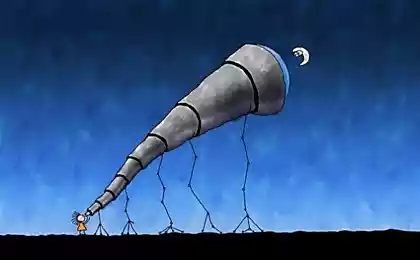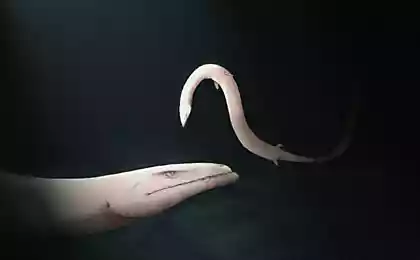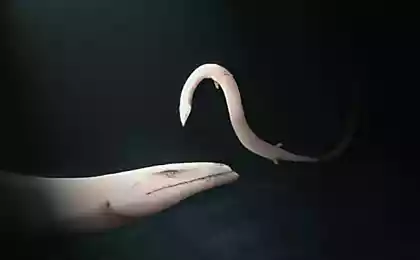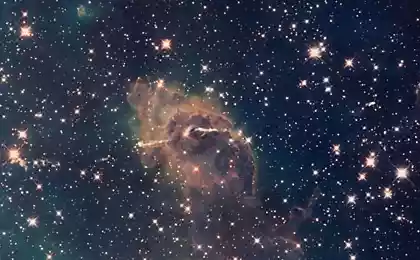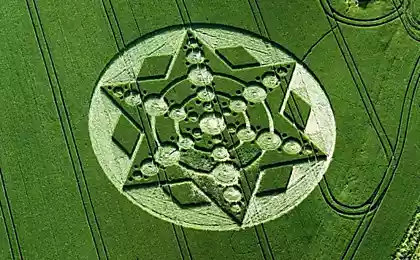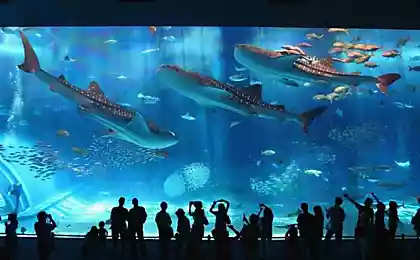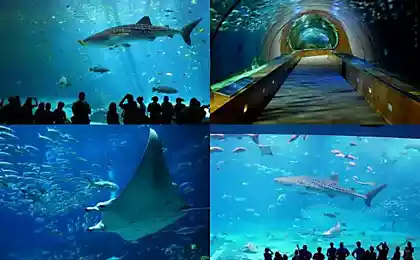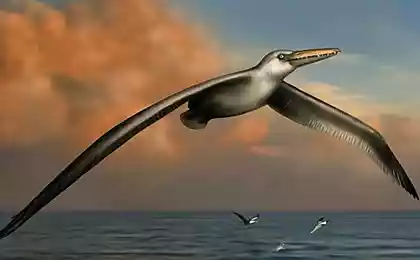2212
10 sea creatures, similar to the aliens
If you were a producer of films and someone would suggest you make a movie in an alien with tentacles that could change shape, become invisible and shoot a blinding cloud of chemicals, you would just sigh and say, "No, it's an octopus." < br />
We take for granted the fact that there are several million of these creatures that live around us. At some point, the science just jumped into the back seat of evolution and provided a terrifying curiosity for some time to steer. However, even among the strangest creatures in the world are those who can be called extreme.
1. Medusa Atoll (Atolla Jellyfish)
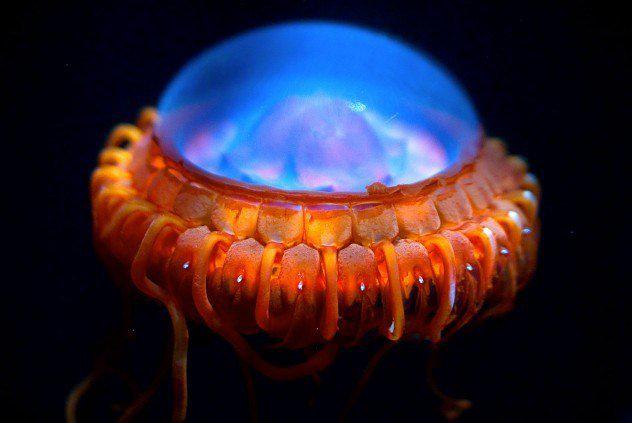
Medusa Atoll quite common. They live in every ocean of the world, but you have them on the beach, of course, will not find, because they usually live at depths exceeding 700 meters. Like many other deep-sea creatures are bioluminescent (they light up like fireflies). However, the atolls are not using your light in order to capture their prey, as do the monkfish - they use their light to escape from enemies. If a predator catches atolls, it begins to emit light pulses rampage similar to the strobe pulses. This light show attracts larger fish, which is more interested in predator attacked the atolls and jellyfish will have a chance to escape.
We have one atolls elongated tentacles that it uses to capture prey. They grab prey end dragging tentacles and helpless creature in the water, tugging it back and forth until, until he left the forces out to fight - just like a fisherman comes with a very big fish.
2. Ordinary ice fish or mackerel icefish (Antarctic Ice Fish)
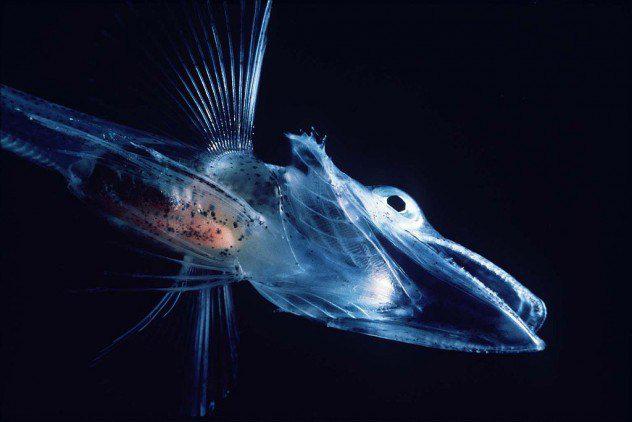
Extremophiles (animals that live in extreme conditions) usually look quite unusual. However, mackerel icefish can rightly claim to be the winner in the competition for the strangest look. As its name implies, this fish lives in deep waters of Antarctica and thrives in temperatures below zero, and to a depth of one kilometer.
These fish are absolutely colorless, transparent, even their blood. They all have the same blood, but it does not contain hemoglobin - the protein contained in red blood cells that is responsible for the movement of oxygen and gives blood red. They are the only vertebrates in the world has such a feature, and researchers are still trying to figure out why it occurred in mackerel icefish. Furthermore, their blood antifreeze protein that does not allow them to freeze the blood and soft tissues. It is because of this protein they can live at temperatures below zero and not turn into a fish icicles.
3. Imperial shrimp (Emperor Shrimp / Periclimenes imperator)
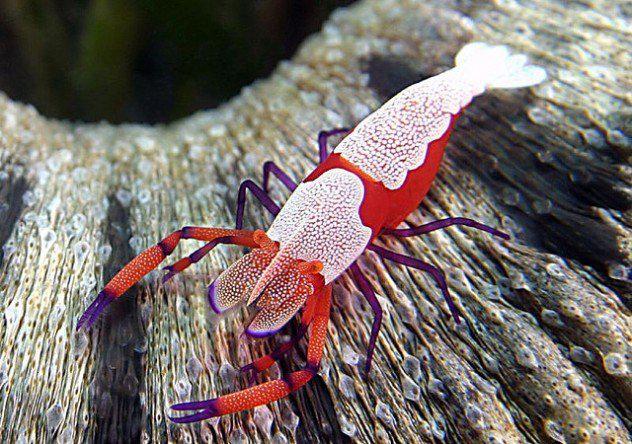
A tiny, colorful imperial shrimp is more like candy than a living creature, but its striking color plays a very important role ... in fact, we do not have any idea why they are so colorful, despite the fact that scientists are studying them more since 1967. It is possible that they simply have no need for camouflage. Imperial shrimp almost exclusively lives on the backs of sea slugs, known as nudibranch, namely the form titled "Spanish Dancer» (Hexabranchus marginatus), which has very few enemies, because it absorbs toxins from their food. In fact, they do no one is hunting, so it's possible that they just love to show off.
4. The Blue Angel (Blue Dragon Sea Slug / Glaucus atlanticus)
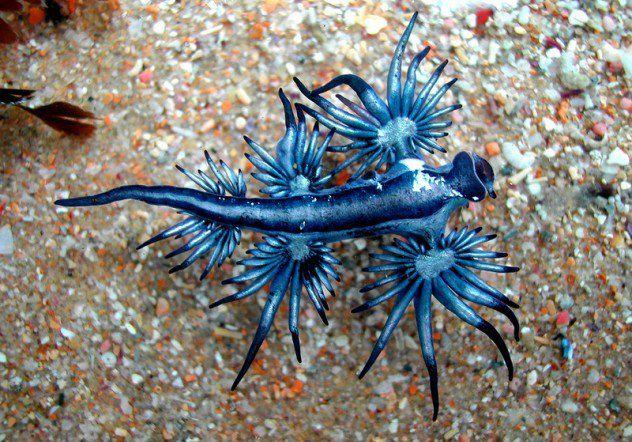
Most animals eat other animals that are less than their size. That is the law of nature. On the other hand, the Blue Angel laughs in the face of logic and preys on the largest and most dangerous creatures, only what he can find - such as the Portuguese ship, but if they are not around, then he preys on other blue angels. Eating tentacles Portuguese boat, blue angels absorb knidotsity stinging cells, which they are hoarding in their body bags to be used in the event that they will attack someone.
However, in this strangeness of this creature does not end there. Most sea slugs crawling on the ocean floor. A blue angels? They swallow air bubbles and floating just under the surface of water. If you look at them from below, they are at the surface, they look like spiders running on the mirror. They just float wherever they are waves, eating anything that will meet on their way.
5. Sea slug Felimare Picta
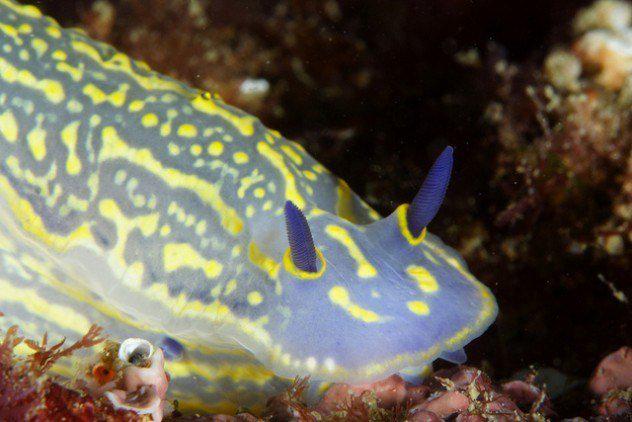
Felimare picta - is the name of species of sea slugs that live in warm, subtropical waters, particularly in the Mediterranean Sea and the Gulf of Mexico. There are six different kinds of subspecies Hypselodoris, and they really are subsections squad nudibranch, all members of which look completely ridiculous.
Representatives squad nudibranch rather small, and usually reach only 20 centimeters in length, although scientists have found several nudibranch longer than 64 centimeters. They are mollusks (and snails), but instead of shells to protect themselves, they use other tricks, hoarded in their colorful sleeves - for example, sweating acid. If it do not you think an extraterrestrial power, it is not clear about what you think aliens.
6. Sea anemone Gorgonevaya blotch (Gorgonian Wrapper / Nemanthus annamensis)
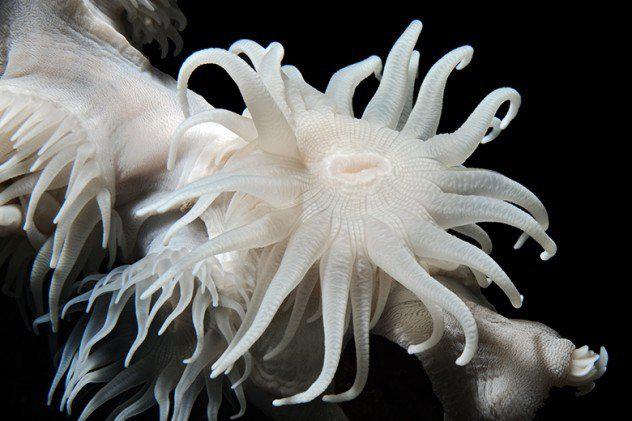
In the waters of the Indian and Pacific oceans inhabit some of the most diverse marine life on the planet, among them is and actin Gorgonevaya blotch. Actinium Gorgonevaya blotch is a sea anemone, so yeah, it's a terrifying creature is a predator. And it is as fierce as it seems, looking at its appearance - anemones such as actin Gorgonevaya blotch produce a substance called knidotsit, which is essentially a small poisonous fragmentation grenade. Anemone tentacles are lined with a layer of cells, and when the fish knidotsitov casual touches their tentacles (or tentacles million), pulls the trigger and the cell explodes, sending the body of the fish paralyzing harpoons.
The biological process in which the anemone shoots venom is one of the fastest reactions in the animal kingdom. To cell knidotsit fired its lethal contents of less than 700 nanoseconds is required (a nanosecond is one billionth of a second).
7. Octopus Vanderpus (Wonderpus)
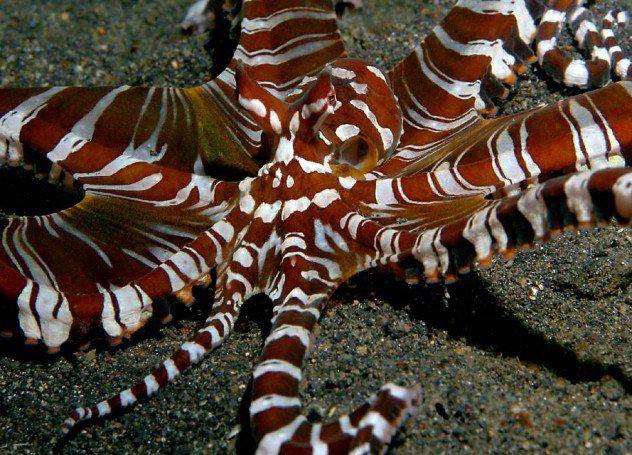
It has one of the coolest Latin names in the animal kingdom Wunderpus photogenicus is a rare predatory octopus, dwell in the Philippine coast. Its name comes from the fact that people are very fond of his pictures, as these octopus is very photogenic. But kittens are also photogenic and Vanderpus not a cute and fluffy as they are. They are hunters, nocturnal. They hunt, pursuing prey crawling on the ocean floor in long and flat tentacles. When they go into Stealth mode, their bright color visibly fades to the color that will allow them to merge with the sand and coral. But if you try to attack one of them, they'll turn bright red and orange to warn predators that they had better keep away from Vanderpusov.
Also, like most octopus Vanderpusy surprisingly smart. This video shows how Vanderpus building coral wall to hide behind it. Every day we learn about Vanderpusah something new (they were only discovered in 2006), and they help us in this - a pattern of white spots on their backs unique to each individual, as a human fingerprint.
8. Samara (Lionfish)
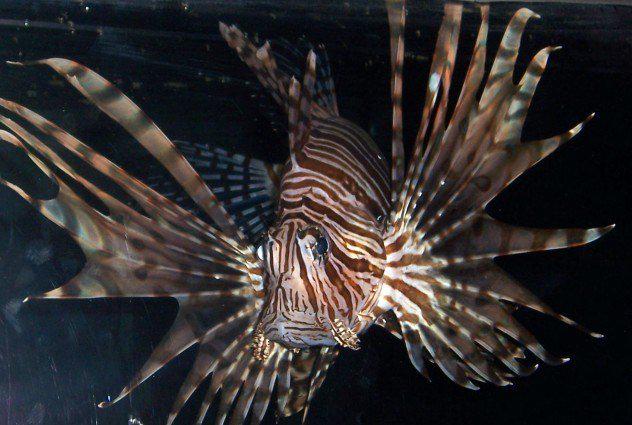
In nature, there are 10 kinds of krylatok, and, needless to say, they are among the most recognizable species of fish in the world. Wildly beautiful and incredibly dangerous, all 10 endemic species of the Indian Ocean and South Pacific, although the two species were introduced to the east coast of North America in 90 years. It was a mistake, because they breed like rabbits underwater, and they have no natural enemies.
In fact, uncontrolled growth of their numbers became so big a problem that researchers in Honduras are trying to teach to hunt sharks krylatok. Usually shark bypass them by. However, ironically the biggest danger for these predators are themselves: in the absence of food, lionfish eat each other.
9. siphonophores Giant (Giant Siphonophore / Praya dubia)
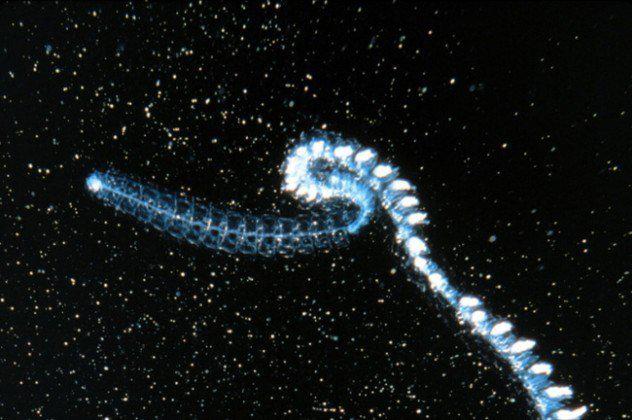
Visually, this creature seems to be something particularly impressive, but in order to truly appreciate the tremendous siphonophores need to look at its size. They live at great depths, and can reach more than 40 meters in length, which is equal to the height of the building and more than thirteen-length adult blue whale.
However siphonophores giant itself is not a single organism. This is actually a colony consisting of millions of beings who are called zooids. Each cluster zooid performs a specific function: some of them are responsible for the food, others for the defense of the colony. When they are close-knit, a colony functions as a single organism. It's like a country, or (perhaps more accurately) to a bunch of dwarfs standing on the shoulders of each other, hidden in a long coat.
And because of that siphonophores live so deep (at a depth of approximately one kilometer from the surface of the water), they are constantly under enormous pressure, which is equal to half a ton per square centimeter of the surface of their bodies. As a result, they are very difficult to study. When they pick up too close to the surface, they burst like balloons due to low blood pressure.
10. Purple Australian worm (Bobbit Worm / Eunice aphroditois)
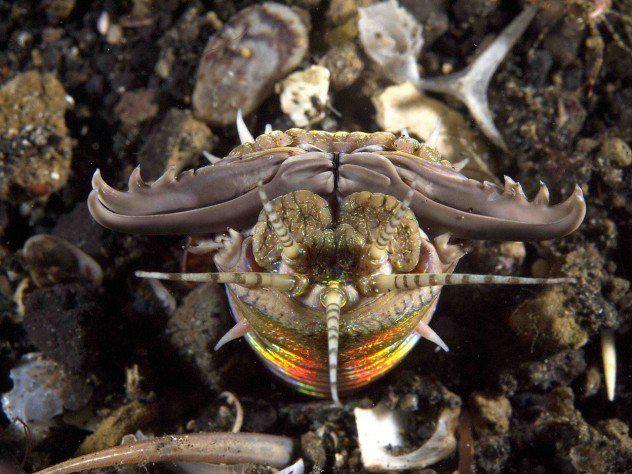
The Australian purple worm is nothing that would not be absurd or ugly. Even its name is derived from a court case in 1993, which featured a woman named Lorena Bobbitt (Lorena Bobbitt), a knife, and ... something else, like a worm. Composed in equal parts of graboida from the movie "Tremors" and the wicked fiend, magenta Australian worm can grow to three meters in length. He dug into the seabed, leaving the bottom surface over only a small part of his body. When a fish swims past him, the worm rolls, grabs the fish with their huge claws and drags her into the ground.
Most instances of Australian purple worm was found not in the ocean, but in quite by accident, tucked away in salt water aquariums. They fall into the tanks, hidden in the rocks and soil, which are taken from the ocean, and then grow slowly without drawing attention to himself. In 2009, the Australian giant purple worm was found in the Blue Reef Aquarium (Blue Reef Aquarium) in England. He was noticed after workers dismantled the aquarium tank to understand why all the fish disappears.
We take for granted the fact that there are several million of these creatures that live around us. At some point, the science just jumped into the back seat of evolution and provided a terrifying curiosity for some time to steer. However, even among the strangest creatures in the world are those who can be called extreme.
1. Medusa Atoll (Atolla Jellyfish)

Medusa Atoll quite common. They live in every ocean of the world, but you have them on the beach, of course, will not find, because they usually live at depths exceeding 700 meters. Like many other deep-sea creatures are bioluminescent (they light up like fireflies). However, the atolls are not using your light in order to capture their prey, as do the monkfish - they use their light to escape from enemies. If a predator catches atolls, it begins to emit light pulses rampage similar to the strobe pulses. This light show attracts larger fish, which is more interested in predator attacked the atolls and jellyfish will have a chance to escape.
We have one atolls elongated tentacles that it uses to capture prey. They grab prey end dragging tentacles and helpless creature in the water, tugging it back and forth until, until he left the forces out to fight - just like a fisherman comes with a very big fish.
2. Ordinary ice fish or mackerel icefish (Antarctic Ice Fish)

Extremophiles (animals that live in extreme conditions) usually look quite unusual. However, mackerel icefish can rightly claim to be the winner in the competition for the strangest look. As its name implies, this fish lives in deep waters of Antarctica and thrives in temperatures below zero, and to a depth of one kilometer.
These fish are absolutely colorless, transparent, even their blood. They all have the same blood, but it does not contain hemoglobin - the protein contained in red blood cells that is responsible for the movement of oxygen and gives blood red. They are the only vertebrates in the world has such a feature, and researchers are still trying to figure out why it occurred in mackerel icefish. Furthermore, their blood antifreeze protein that does not allow them to freeze the blood and soft tissues. It is because of this protein they can live at temperatures below zero and not turn into a fish icicles.
3. Imperial shrimp (Emperor Shrimp / Periclimenes imperator)

A tiny, colorful imperial shrimp is more like candy than a living creature, but its striking color plays a very important role ... in fact, we do not have any idea why they are so colorful, despite the fact that scientists are studying them more since 1967. It is possible that they simply have no need for camouflage. Imperial shrimp almost exclusively lives on the backs of sea slugs, known as nudibranch, namely the form titled "Spanish Dancer» (Hexabranchus marginatus), which has very few enemies, because it absorbs toxins from their food. In fact, they do no one is hunting, so it's possible that they just love to show off.
4. The Blue Angel (Blue Dragon Sea Slug / Glaucus atlanticus)

Most animals eat other animals that are less than their size. That is the law of nature. On the other hand, the Blue Angel laughs in the face of logic and preys on the largest and most dangerous creatures, only what he can find - such as the Portuguese ship, but if they are not around, then he preys on other blue angels. Eating tentacles Portuguese boat, blue angels absorb knidotsity stinging cells, which they are hoarding in their body bags to be used in the event that they will attack someone.
However, in this strangeness of this creature does not end there. Most sea slugs crawling on the ocean floor. A blue angels? They swallow air bubbles and floating just under the surface of water. If you look at them from below, they are at the surface, they look like spiders running on the mirror. They just float wherever they are waves, eating anything that will meet on their way.
5. Sea slug Felimare Picta

Felimare picta - is the name of species of sea slugs that live in warm, subtropical waters, particularly in the Mediterranean Sea and the Gulf of Mexico. There are six different kinds of subspecies Hypselodoris, and they really are subsections squad nudibranch, all members of which look completely ridiculous.
Representatives squad nudibranch rather small, and usually reach only 20 centimeters in length, although scientists have found several nudibranch longer than 64 centimeters. They are mollusks (and snails), but instead of shells to protect themselves, they use other tricks, hoarded in their colorful sleeves - for example, sweating acid. If it do not you think an extraterrestrial power, it is not clear about what you think aliens.
6. Sea anemone Gorgonevaya blotch (Gorgonian Wrapper / Nemanthus annamensis)

In the waters of the Indian and Pacific oceans inhabit some of the most diverse marine life on the planet, among them is and actin Gorgonevaya blotch. Actinium Gorgonevaya blotch is a sea anemone, so yeah, it's a terrifying creature is a predator. And it is as fierce as it seems, looking at its appearance - anemones such as actin Gorgonevaya blotch produce a substance called knidotsit, which is essentially a small poisonous fragmentation grenade. Anemone tentacles are lined with a layer of cells, and when the fish knidotsitov casual touches their tentacles (or tentacles million), pulls the trigger and the cell explodes, sending the body of the fish paralyzing harpoons.
The biological process in which the anemone shoots venom is one of the fastest reactions in the animal kingdom. To cell knidotsit fired its lethal contents of less than 700 nanoseconds is required (a nanosecond is one billionth of a second).
7. Octopus Vanderpus (Wonderpus)

It has one of the coolest Latin names in the animal kingdom Wunderpus photogenicus is a rare predatory octopus, dwell in the Philippine coast. Its name comes from the fact that people are very fond of his pictures, as these octopus is very photogenic. But kittens are also photogenic and Vanderpus not a cute and fluffy as they are. They are hunters, nocturnal. They hunt, pursuing prey crawling on the ocean floor in long and flat tentacles. When they go into Stealth mode, their bright color visibly fades to the color that will allow them to merge with the sand and coral. But if you try to attack one of them, they'll turn bright red and orange to warn predators that they had better keep away from Vanderpusov.
Also, like most octopus Vanderpusy surprisingly smart. This video shows how Vanderpus building coral wall to hide behind it. Every day we learn about Vanderpusah something new (they were only discovered in 2006), and they help us in this - a pattern of white spots on their backs unique to each individual, as a human fingerprint.
8. Samara (Lionfish)

In nature, there are 10 kinds of krylatok, and, needless to say, they are among the most recognizable species of fish in the world. Wildly beautiful and incredibly dangerous, all 10 endemic species of the Indian Ocean and South Pacific, although the two species were introduced to the east coast of North America in 90 years. It was a mistake, because they breed like rabbits underwater, and they have no natural enemies.
In fact, uncontrolled growth of their numbers became so big a problem that researchers in Honduras are trying to teach to hunt sharks krylatok. Usually shark bypass them by. However, ironically the biggest danger for these predators are themselves: in the absence of food, lionfish eat each other.
9. siphonophores Giant (Giant Siphonophore / Praya dubia)

Visually, this creature seems to be something particularly impressive, but in order to truly appreciate the tremendous siphonophores need to look at its size. They live at great depths, and can reach more than 40 meters in length, which is equal to the height of the building and more than thirteen-length adult blue whale.
However siphonophores giant itself is not a single organism. This is actually a colony consisting of millions of beings who are called zooids. Each cluster zooid performs a specific function: some of them are responsible for the food, others for the defense of the colony. When they are close-knit, a colony functions as a single organism. It's like a country, or (perhaps more accurately) to a bunch of dwarfs standing on the shoulders of each other, hidden in a long coat.
And because of that siphonophores live so deep (at a depth of approximately one kilometer from the surface of the water), they are constantly under enormous pressure, which is equal to half a ton per square centimeter of the surface of their bodies. As a result, they are very difficult to study. When they pick up too close to the surface, they burst like balloons due to low blood pressure.
10. Purple Australian worm (Bobbit Worm / Eunice aphroditois)

The Australian purple worm is nothing that would not be absurd or ugly. Even its name is derived from a court case in 1993, which featured a woman named Lorena Bobbitt (Lorena Bobbitt), a knife, and ... something else, like a worm. Composed in equal parts of graboida from the movie "Tremors" and the wicked fiend, magenta Australian worm can grow to three meters in length. He dug into the seabed, leaving the bottom surface over only a small part of his body. When a fish swims past him, the worm rolls, grabs the fish with their huge claws and drags her into the ground.
Most instances of Australian purple worm was found not in the ocean, but in quite by accident, tucked away in salt water aquariums. They fall into the tanks, hidden in the rocks and soil, which are taken from the ocean, and then grow slowly without drawing attention to himself. In 2009, the Australian giant purple worm was found in the Blue Reef Aquarium (Blue Reef Aquarium) in England. He was noticed after workers dismantled the aquarium tank to understand why all the fish disappears.
